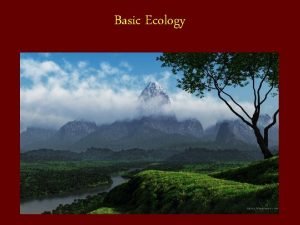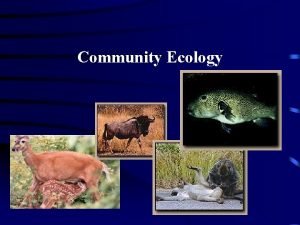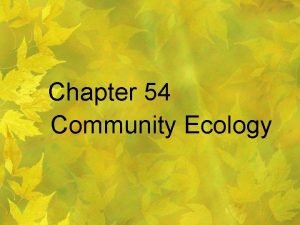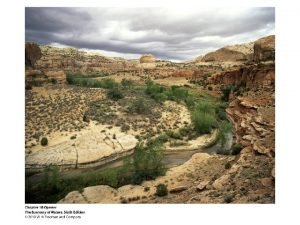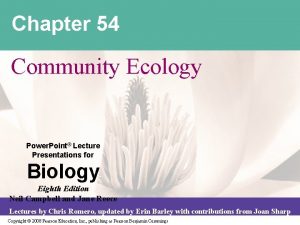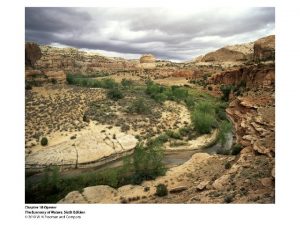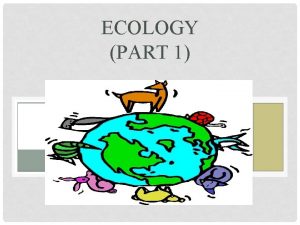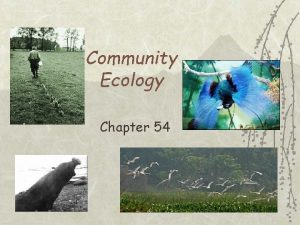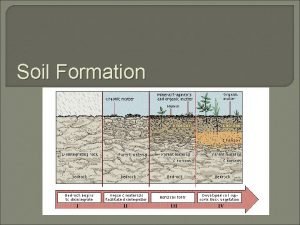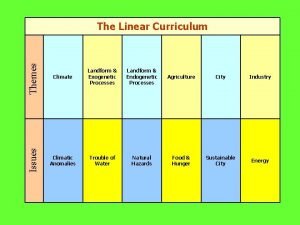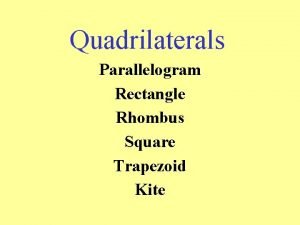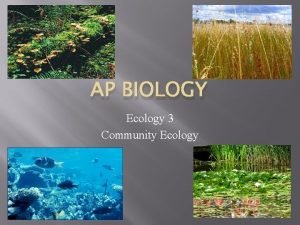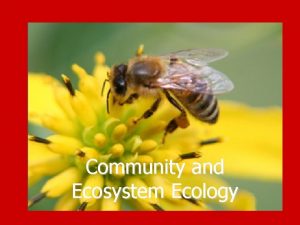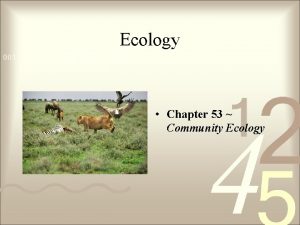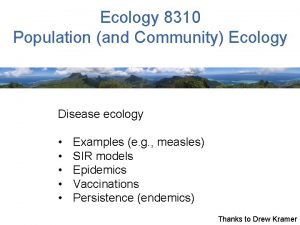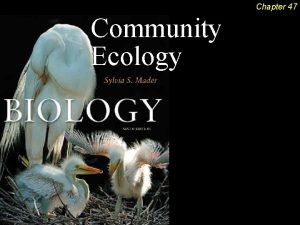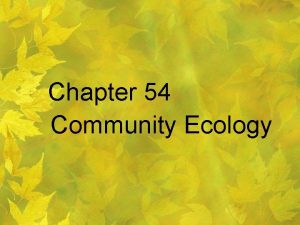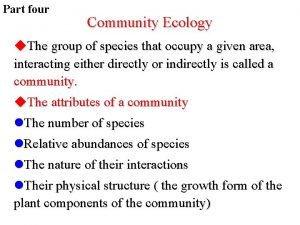Part four Community Ecology u What processes shape



























- Slides: 27

Part four Community Ecology u. What processes shape these patterns of community structure? u. How will communities respond to the addition or removal of a species? u. Why are communities in some environments more or less diverse than others?

Chapter 17 Factors Influencing the Structure of Communities u 17. 1 The Fundamental Niche Constrains Community Structure u 17. 2 Species Interactions Are Diffuse u 17. 3 Food Webs Illustrate Indirect Interactions u 17. 4 Food Webs Suggest Controls of Community Structure

Chapter 17 Factors Influencing the Structure of Communities u 17. 5 Species Interactions along Environmental Gradients Involve Both Stress Tolerance and Competition u 17. 6 Environmental Heterogeneity Influences Community Diversity u 17. 7 Resource Availability Can Influences Plant Diversity within a Community

17. 1 The Fundamental Niche Constrains Community Structure u. All living organisms have a range of specific environmental condition under which they can successfully survive, grow, and reproduce. u. The conditions under which an organism can function successfully are the consequence of a wide variety of physiological, morphological and behavioral adaptations. u. Environmental conditions vary in time and space. u. Fundamental niches

Fundamental Niche Fundamental niches of hypothetical species along environmental gradient (e. g. T, Moisture, elevation) • All species have bellshaped niches • Niche overlap • Each species has limits beyond which it can’t survive • For any given range of environment, only a subset of species can survive • As environments change, abundance of species will change. The distribution of fundamental niches along the environmental gradient represents a primary constraint on the structure of communities.

Distribution of three species Geographic distribution of three tree species that are part of the two forest communities presented in Tables 16. 1 and 16. 2. Distribution of these three species overlap in West Virginia. Niche overlap

17. 2 Species Interactions Are Diffuse u. One reason many experiments tend to underestimate the importance of species interactions in communities is that such interactions are often diffuse, involving a number of species. u. Competition Experiment by Norma Fowler (UT Austin) l Usually the removal of a single species will have very limited effects. l Removing groups of species can have large effects.

u. It is difficult to determine the effect of any given species on another. u. But collectively, competition may be an important factor limiting the abundance of all species involved. u. Diffuse interactions, where one species may be influenced by interactions with many different species, is not limited to competition.

Any single predator species may have a limited effect on the snowshoe hare population; together, they regulate its population.

17. 3 Food Webs Illustrate Indirect Interactions u. Food webs also provide information on indirect effects. l Presence of lynx is good for white spruce due to survival of seedlings. u. The key feature of indirect interactions is that they can potentially arise throughout the entire community because of a single direct interaction between only two component species.

Another example of predation in shaping structure of communities l. Starfish is a keystone predation. In the absence of predation, what happened?

u. An experiment of indirect interaction l The starfish preys on many species of mussels, barnacles, limpets, etc l Removing starfish from experimental plots compared to normal situation l Number of prey species in experimental plots reduced l Diversity decreased as better competitors excluded other species

u. Predation can also influence outcome of interactions between prey species u. This type of indirect interactions is called keystone predation, where the predator enhances one or more inferior competitors by reducing the abundance of the superior competitor.

u. Apparent competition l In the absence of predator, the population of each prey is regulated by purely intraspecific density dependent mechanisms. l Neither prey species compete, directly or indirectly, with the other. l Predator abundance depends on the combined abundance of all prey species. l Under these conditions, the combined population abundance of the two prey species will support a higher predator density than in situations where only a single prey species occurs.

Apparent competition The prey species are less abundant when coexisting than when in the other species’ absence. Experimental supports: Nettle aphid, grass aphid and ladybug beetle (page 359, textbook) Brought nettle aphid plants to grass aphid plants together suppressed both population, as a results of larger ladybug beetle population.

Indirect commensalism Benefit midge larva, neutral to salamander Two species of herbivorous species Daphnia (water fleas) Two predators: Midge larva and Larval salamander Each predator prey on one species In a pond Where salamander larval were present, large Daphnia was low, small was high; where absent, small Daphnia were absent, midges could not survive

17. 4 Food Webs Suggest Controls of Community Structure How do you tell which ones are important in controlling community structure? Are all interactions important? u. Hypothesis one: All species interactions are important, removing any one species may have a cascading effect on all others. u. Hypothesis two: Only a smaller subset of species interactions are controlling community structure. System will not collapse until enough species are removed.

• Difficult to study (there are some dominant species like starfish, but majority is mystery). One approach is splitting species into functional groups – Each group has a similar function and perhaps can replace each other Trophic levels 1. Primary producers 2. Herbivores 3. Carnivores

u. Bottom-up control l Plant population control herbivore populations, which in turn control the diversity and population density of carnivore population. u. Top-down control l Predator (carnivore) populations control the diversity of prey species, and the prey of the prey, and so on. u. Bottom-up control is very common. Mostly, community structure is regulated by bottom-up control.

17. 5 Species Interactions along Environmental Gradients Involve Both Stress Tolerance and Competition u. Biological structure of a community is constrained by environmental tolerances of the species (fundamental niche). Those tolerances are often modified through both direct and indirect interactions with other species (realized niche). u. Competitors and predators can function to restrict a species in a community and mutualists can function to facilitate a species’s presence and abundance within a community.

As the availability of water (or nutrients) increases along a supply gradient (Figure 17. 9) , the competitive advantage shifts from those species adapted to low availability of water (high root production) to those species that allocate carbon to leaf production and height but that require higher water availability to survive (Figure 17. 10). Figure 17. 10 General trends in plant adaptations that increase Figure 17. 9 Distribution of tree fitness along a soil moisture species along a soil-moisture gradient.

17. 6 Environmental Heterogeneity Influences Community Diversity u. As environmental conditions change from location to location, so will the set of species that can potentially occupy the area and the way they interact. u. Environmental conditions are typically not homogeneous even within a given community. Variations in soil moisture Variations in nitrogen

u. How does local environmental heterogeneity within a community influence patterns of diversity? Late Robert Mac. Arthur 13 communities in northeastern US u. Increased vertical structure means more resources and living space and a greater diversity of potential habitats. Relationship between bird species diversity and foliage height diversity for deciduous forest communities in eastern North America. (x is not height)

17. 7 Resource Availability Can Influence Plant Diversity within a Community u. High nutrients will support high rates of photosynthesis, plant growth, and a high density of plants. u. How does nutrient availability influence plant diversity in communities?

Increasing nutrient availability has been to decrease diversity. Why? Michael Huston, ORNL, TN (Texas State Uni. ) Relationship of tree species richness to a simple index of soil fertility for 46 forest communities in Costa Rica.

Hypothesis Low nutrient availability reduces growth rates and supports a lower density and biomass of vegetation. Species that might dominate under higher nutrient availability can not realize their potential growth rates and biomass and as a result are unable to displace slower growing, less competitive species. Supported by many other experiments (Rothamsted Experimental Station in Great Britain, 1859 -)

Factors Influencing the Structure of Communities u. Fundamental Niche u. Diffuse and Indirect Interactions u. Species’ Stress Tolerance and Its Competition u. Environmental Heterogeneity u. Resource Availability How do we build a community ?
 Shapes with four sides and four corners
Shapes with four sides and four corners Concurrent processes are processes that
Concurrent processes are processes that Four levels of ecology
Four levels of ecology 52
52 Ecosystem vs community
Ecosystem vs community Community ecology
Community ecology Chapter 3, section 1: community ecology answer key
Chapter 3, section 1: community ecology answer key Chapter 54 community ecology
Chapter 54 community ecology Evolution and community ecology guided notes
Evolution and community ecology guided notes Definition of community ecology
Definition of community ecology More diverse
More diverse Chapter 5 evolution and community ecology
Chapter 5 evolution and community ecology Ecosystems interactions
Ecosystems interactions Community definition ecology
Community definition ecology Ecology examples
Ecology examples Symbiosis examples
Symbiosis examples Chapter 54 community ecology
Chapter 54 community ecology Ecology part 1
Ecology part 1 4 printmaking techniques
4 printmaking techniques Formation of soil
Formation of soil What is community dynamics
What is community dynamics Exogenetic processes part 2
Exogenetic processes part 2 Aerodynamic shapes
Aerodynamic shapes Shape matching and object recognition using shape contexts
Shape matching and object recognition using shape contexts Template matching
Template matching Quadrilateral property
Quadrilateral property Four sided shape with two sets of parallel lines
Four sided shape with two sets of parallel lines What is a quadilateral
What is a quadilateral


